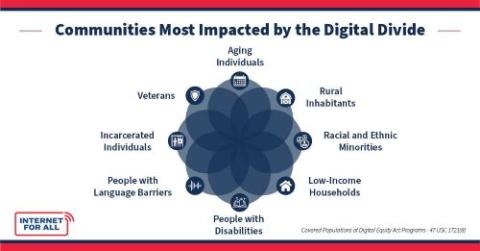Last month NTIA announced our first Capacity Award from the Digital Equity Act, which awarded approximately $9 million to Nevada to implement digital inclusion programs across the state.
As required by the Digital Equity Act, the $1.25 billion Digital Equity Competitive Grant Program will be established within 30 days of our first State Digital Equity Capacity Grant Program award and will make hundreds of millions of dollars available in the first Notice of Funding Opportunity to implement digital inclusion projects.
Examples of eligible applicants for this program include, a political subdivision, agency, or instrumentality of States, Indian Tribes, Alaska Native entities, and Native Hawaiian organizations (Native Entities), nonprofits, community anchor institutions, local educational agencies, and workforce development organizations. U.S. territories are also eligible to apply through a separate process.
As these eligible applicants prepare to apply for the first grants from the Digital Equity Competitive Grant Program, it is important to craft applications and projects that help create the conditions in which individuals and communities have the information technology capacity needed for full participation in the society and economy of the United States.
The Bipartisan Infrastructure Law mandates that funding be directed towards programs designed to empower those impacted by the digital divide, known as Covered Populations. Covered Populations include low-income households, aging populations, incarcerated individuals, veterans, people with disabilities, people with language barriers, racial and ethnic minorities, and rural inhabitants.
It is crucial to recognize that Covered Populations are not monolithic groups but encompass individuals with unique needs and lived experiences. When individuals are members of more than one of the Covered Populations they may experience even greater barriers to accessing digital technology, underscoring the importance of tailored solutions.

Digital Equity is more than just an acknowledgement of the digital divide—it is about creating tangible socioeconomic opportunities.
For example, a veteran and older American living in a rural area can access digital training programs to utilize telehealth services, obtaining essential health care to improve their health outcomes. They can also engage in workforce training to enhance their economic well-being and remain connected to loved ones who live far away. Thoughtful and inclusive strategies can transform lives by providing fair and meaningful access to digital resources for all.
To have the greatest impact among Covered Populations, NTIA encourages stakeholders to consider whether forming a partnership is right for you. We achieve more when we work together. Consider pooling your resources and expertise with other organizations to submit collaborative proposals that address the needs of your communities. By working together, you can create more effective and comprehensive solutions that drive meaningful change and improve the lives of those you serve.
Applicants for the Digital Equity Competitive program should take action now to get ready to apply.
Develop a timeline to complete your application and be realistic about the time it can take to write and revise the application.
If you are planning to apply through a partnership, start getting your partnership letters and authorizations written and signed. Partnerships can enhance an application by providing diverse expertise, increasing credibility, and extending a project’s reach.
Follow NTIA across our social media channels and check out the Digital Equity Technical Assistance hub for more resources.
As part of the Biden-Harris Administration’s Internet for All initiative, there are a variety of resources you can use to see how funding may be determined in your states and to create data-driven applications.
- NTIA InternetforAll Digital Equity Landing Page
- Digital Equity Act Population Viewer
- Your State’s Plan Where can I find my state’s plan?
Visit the NTIA website for more details and to sign up to receive email updates for more information. There will be additional guidance for all applicants on our website, in addition to live webinars and public office hours.
If those resources do not provide the information you need, you can reach out to NTIA at DigitalEquity.

